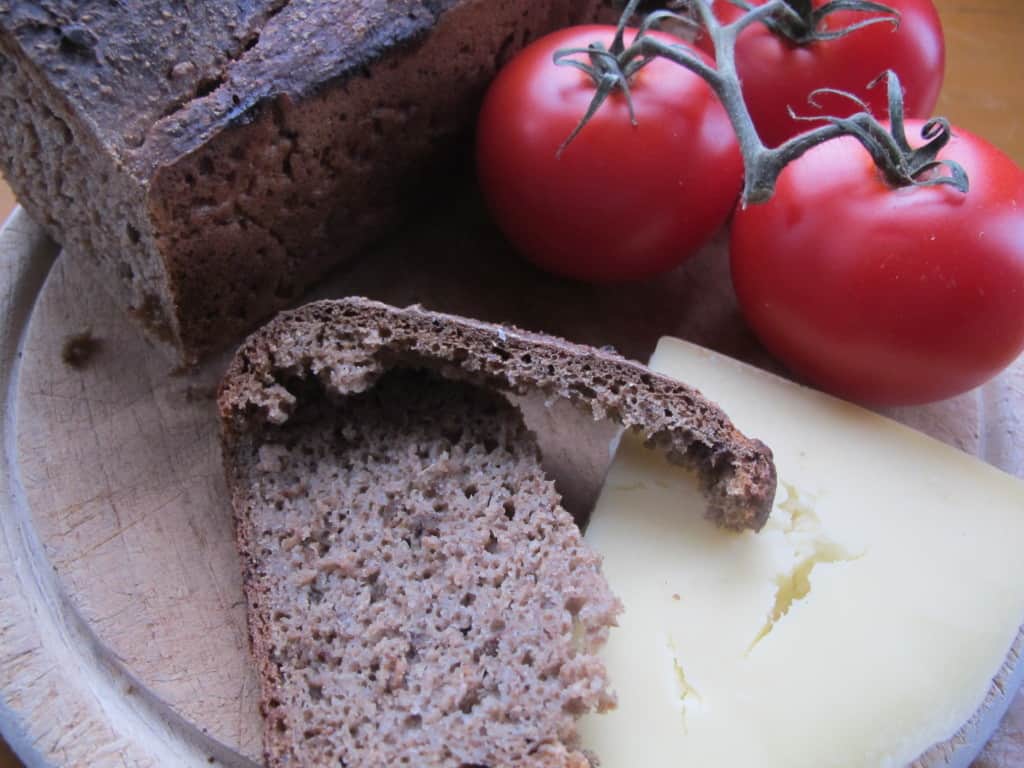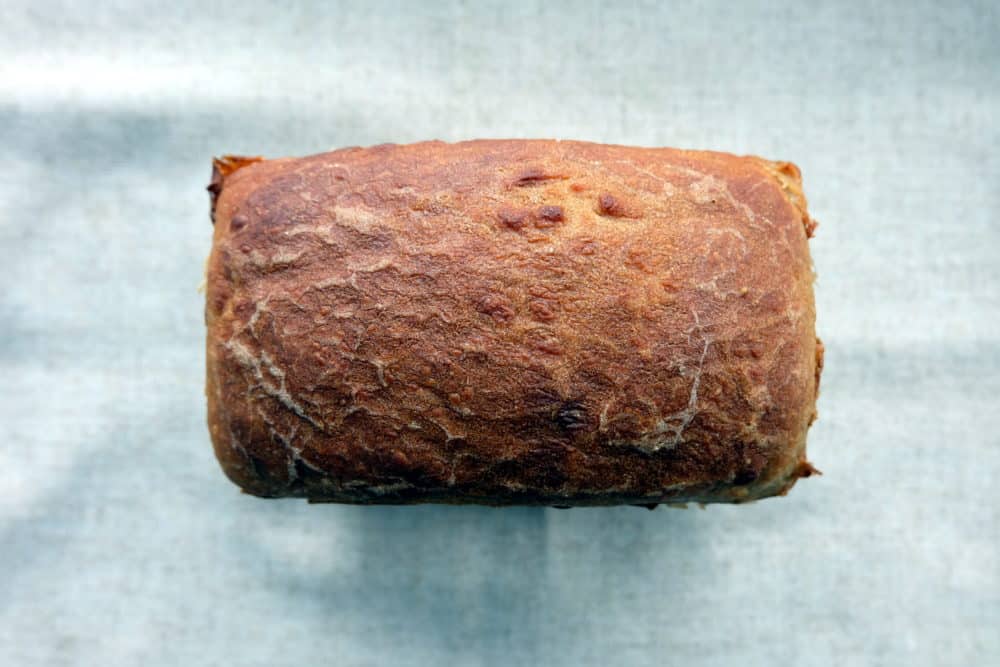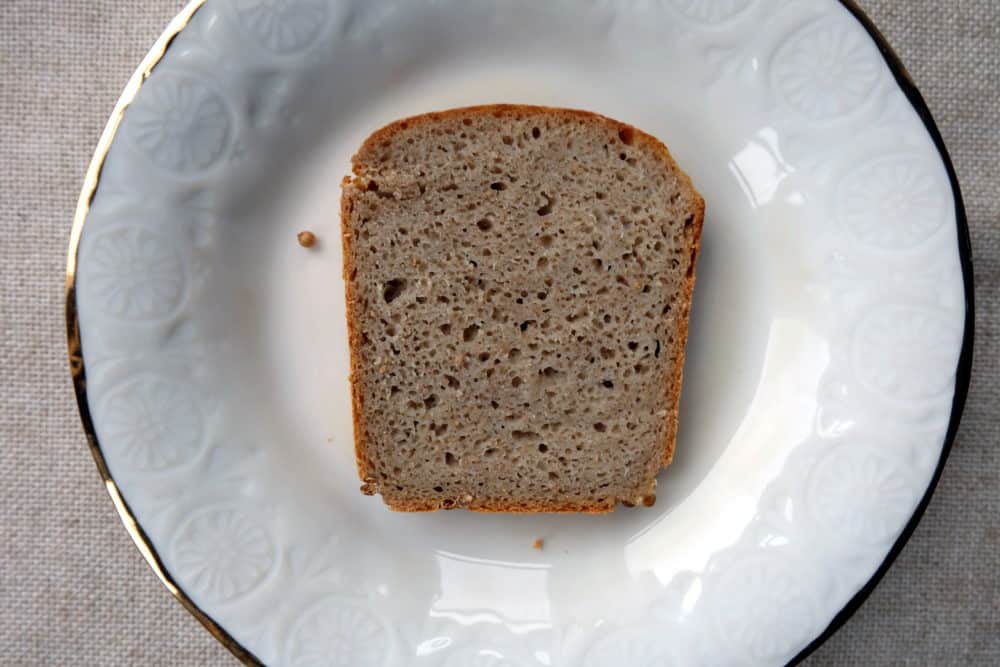Rye flour is my favourite flour for bread baking. It produces breads with a rich and hearty taste, complex nutty flavours and a moist, dense and chewy texture. 100% pure rye breads are higher in fibre and lower in fat than wheat loaves and therefore have added health benefits. From a practical viewpoint, I also love the longevity of rye loaves. Here are my top four 100% rye bread recipes, all based on sourdough baking.

100% pure rye flour baking notes
There is one thing in all-rye bread baking I don’t enjoy – the sticky dough which is difficult to handle. However, the good thing is that rye gluten isn’t particularly strong and kneading is therefore not required.
For purist reasons, I prefer not to add colouring agents such as molasses, malt, treacle, caramel, coffee or cocoa to achieve that rich, dark colour associated with rye breads.
Having experimented with quite a few 100% rye bread recipes, my favourite loaves use sourdough, no commercial yeast. All recipes below are 100% rye sourdough loaves, without wheat flour. If you haven’t already got a rye sourdough starter, you can easily prepare one from scratch.
My top four 100% rye bread recipes
I use rye flour in most of my bread recipes, it adds great depth of flavour and taste. The following 100% rye bread recipes take this to the next level by using only rye flour.
Rye Bread Recipe #1: Andrew Whitley’s Russian 100% Rye Sourdough Bread Recipe
The recipe I love most requires only four ingredients: rye sourdough starter, rye flour, water and salt. I usually add a bit of Brotgewürz as an optional addition as it enhances the flavour of the loaf.
The recipe has been taken from the book Bread Matters: Why and How to Make Your Own by Andrew Whitley and has been slightly adapted. Here is how it’s done –
Day 1 – Prepare Sourdough
- In a bowl, combine 50g rye sourdough starter, 220g wholemeal rye flour and 220g lukewarm water.
- Cover and keep at room temperature for approx. 16 – 24 hours.
Day 2 – Prepare Dough
- In a large bowl, combine 440g of yesterday’s sourdough mixture (keep the remaining sourdough for your next bake), 260g rye flour, 200g lukewarm water and 7g salt (plus 1 large tbsp of Brotgewürz if you like).
- Mix thoroughly, place the dough back into the bowl, cover and rest for approx. 30 minutes.
- Grease a lidded pullman loaf tin (I use vegetable oil and a kitchen brush to do this).
- Transfer the dough from the bowl to the tin. This is best done with wet hands and dough scraper. Distribute evenly.
- Sprinkle a little rye flour on top, then place the lid on the tin.
- Place the tin in the fridge overnight.
Day 3 – Bake
- Take the tin out of the fridge and preheat the oven to 240°C.
- The dough should have risen considerably – if the dough half-filled the tin on day 2, it should now be close to the top.
- Bake at 240°C for 10 minutes, then turn the heat down to 220°C and bake for another 45 minutes or so. If in any doubt, give it a little longer in the oven – rye loaves hold a lot of water.
- Cool on a wire rack.
- Once completely cooled, wrap in cling film and leave to rest for a day. The flavour of the loaf will develop further in that time and the crumb will improve.
Rye Bread Recipe #2: Dan Lepard’s Sour 100% Rye Bread
Another one of my all-time favourites, this 100% rye bread recipe uses a rye sourdough starter, fine rye flour and a clever gelatinised rye mix (made by mixing boiling water and rye flour) to aid the elasticity of the crumb. It’s a recipe from the book The Handmade Loaf: The Best European and Artisan Recipes for Homemade Bread by Dan Lepard. I ususally add caraway seeds or coriander seeds for extra flavour. Here are the recipe and my baking notes.

Day 1 – Prepare Gelatinised Rye Mix & Sourdough
- Prepare a medium bowl and weigh in 60g fine white rye flour. Boil 240g water and cool it to 90°C (I use a Thermapen to check this). Add the water to the bowl and whisk it in. Try to avoid too many lumps by whisking quickly and vigorously. Cover the bowl and leave for 16 – 24 hours (same as the sourdough below).
- In another bowl, combine 50g rye sourdough starter with 100g dark rye flour and 100g water. Mix well, then cover and set aside at room temperature for 16 – 24 hours.
Day 2 – Main Dough
- In a large bowl, combine 50g cold water with 200g rye sourdough (the rest goes back into the fridge for your next bake). Whisk together.
- Add all but 2 tbsp of the gelatinised rye mix into the bowl and whisk in.
- Add 300g fine white rye flour, 7g salt and a tbsp of rapeseed oil and mix well. I use a silicone spatula to do this and avoid getting stuck in with my hands – it’s a soft sticky dough.
- Prepare a loaf tin (the one I use is 15.2 x 10.2 x 12.7 cm), spread a tbsp of caraway or coriander seeds at the bottom, then – with wet hands – take the dough and put it into the tin. Even out the top and spread the gelatinised rye mix over the top.
- Cover with a polythene bag and put into the fridge for 16 – 24 hours.
Day 3 – Bake
- Take out the loaf tin from the fridge, the dough will have almost doubled in size.
- Preheat the oven to 220°C.
- Bake for 50 minutes.
- Leave to cool on a wire rack.
- Once cold, wrap in kitchen baking parchment, tie well with string and leave for a day before slicing.
The bread tastes great with smoked fish, smoked meats with horseradish or root vegetable soups.

Rye Bread Recipe #3: German-Style Pure 100% Rye Bread Recipe
I bake this 100% rye bread recipe almost every week. It uses an old bread soaker which is popular in German sourdough bread baking.
Day 1 morning – Prepare Sourdough
- 10g sourdough starter
- 140g fine rye flour
- 110g water
- Combine ingredients in a bowl, cover and keep at room temperature for 16 – 24 hours.
Day 2 morning – Enhance Sourdough
- 260g sourdough from the day before
- 200g fine rye flour
- 160g water
- Combine ingredients in a bowl, cover and keep at room temperature for 3 hours.
Day 2 morning – Prepare Old Bread Soaker
- 50g old stale bread (preferably dark sourdough bread)
- 100g water
- Soak old bread in a small bowl for 3 hours, then puree with a stick blender.
- This is a technique commonly used in German-style bread baking and adds great flavour.
Day 2 afternoon – Prepare Main Dough
- 610g sourdough (as prepared in the above steps, the remaining 10g of sourdough go back into the fridge for your next bake)
- 325g dark rye flour
- 250g fine rye flour
- 150g pureed bread soaker (as per the above)
- 400g water
- 16g salt
- 2 tbsp fennel or coriander seeds (optional)
- Combine the ingredients and mix well.
- Place the dough in a bowl, cover and keep at room temperature for approx. 30 minutes.
- Butter a large heavy-duty loaf tin (I used a Pullman loaf tin, 33 cm long, 10 cm wide) and sprinkle some crushed fennel or coriander seeds onto the bottom of the pan (these will infuse the bread during baking).
- Move the dough from the bowl into the loaf tin and distribute it evenly (best done with wet hands).
- Cover the loaf tin with a lid if you are using the Pullman loaf tin. If you don’t have a lid for the loaf tin, place the tin into a polythene plastic bag. Covering it is important to prevent the dough from drying out during the final proof.
- Place the covered loaf tin in the fridge overnight – approximately 10 to 12 hours.
Day 3 – Bake
- Take the loaf tin out of the fridge. The dough should have visibly risen.
- Preheat the oven to 200°C.
- Once the oven is preheated, bake for 65 minutes. If you are using a Pullman loaf tin, leave the lid on during the bake. If you are not using a Pullman loaf tin, you can bake the bread without a lid. Leaving the lid on will keep the bread moister but you will be able to achieve great results without the lid as well.
- If using a lidded loaf tin, take the lid off for the last 10 minutes of the baking time, to help brown the top crust.
- Cool on a wire rack.
Rye Bread Recipe #4: Traditional German 100% Rye Pumpernickel
Finally, taking pure 100% rye bread recipes and baking one step further, try my traditional German pumpernickel recipe, using rye grains and cracked rye instead of flour.